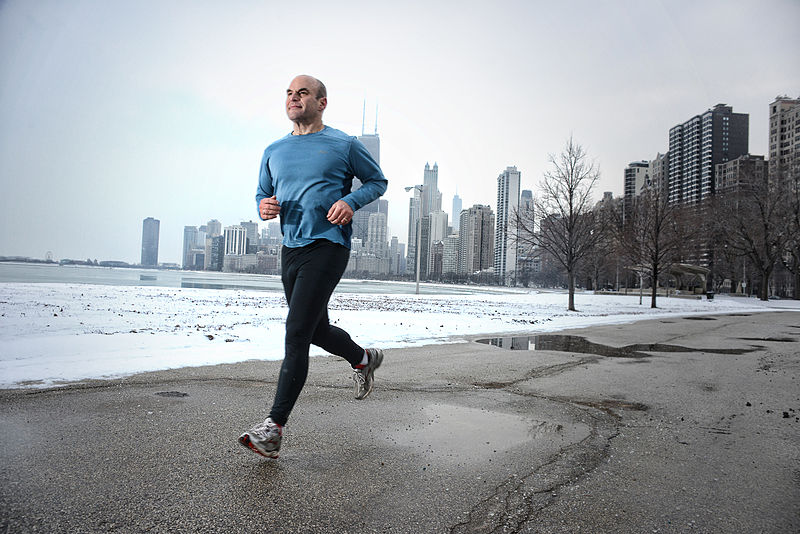By Gilbert B. Elwyn
 With the arrival of colder temperatures and shorter days, runners must make a few adjustments to continue running in safety and comfort.
With the arrival of colder temperatures and shorter days, runners must make a few adjustments to continue running in safety and comfort.
If you are going to be running when the light is less than optimal, wear a reflector vest, a blinking light, or some other workable device to let vehicles know that you are sharing the road with them. Light colored clothing is recommended over dark. Fortunately, most running shoes feature reflective patches. If the problem is that you are running in an area where you can’t see the running surface: don’t. Find another place to run. The risk of a break, bruise, or sprain is too great. An option might be to try to find a track that is open to the public. Robin Williams (a very good cross country runner in his time) said that running on a track made him feel ”like a gerbil.” Nevertheless, it beats being in traction.
There are various theories as to the best way to loosen up and warm down, but it is pretty universally agreed that, particularly in cold weather, muscles don’t do well using the abrupt start/stop approach.
One method is to begin by walking and slowly increase to a medium run, followed by a series of stretches. Another method (the one I used) begins with stretching, followed by a slow to medium trot, and followed by yet another series of stretches if needed. (BTW for the stretches, if it’s still being made, The Team Stick is wonderful. It is a cross between a rolling pin and a baton.) A warm down routine could include a medium run that gradually decreases to a walk until your breathing pattern subsides to close to its usual rhythm. Follow this with a light series of stretches.
When the temperatures drop, think “layering” when you dress for a run. Layering can mean one of two things: 1) dress in layers, so that, as your body heat rises, you can remove clothing to keep from getting overheated (my running group always had an assortment of “throw-aways” for this purpose) and 2) purchase and wear scientifically engineered layers of clothing which will wick away moisture, keep you dry and warm, and protect you against the wind. Your local running store should be able to help you with both of these options. Do not forget the importance of keeping your extremities warm and dry. For this purpose, there are winter caps (I still prefer a stocking cap for very cold runs), thermal running gloves, and double-layer wicking socks available. An important reminder – even though it is cold, drink water!
Goal Race: In the Day Tripper section of this magazine, you will find an article about the Cowpens National Historical Battlefield site. Each January, the Spartanburg Running Club hosts an annual Race for the Grasshopper 5k (5 kilometer / 3.1 mile) road race around this interesting site. The weather is not always cooperative, but the race is a good one for a beginning runner and the Spartanburg Running Club usually does a fine job as host. If you’re looking for a race to “cut your teeth on” this very well might be it. So here are a few tips for your first race.
1) Train – make certain that you have gradually and surely made your way to the goal distance.
2) Enjoy the race – do not set a goal pace for yourself for your first run. The goal is to enjoy the experience and, as a running buddy said, to finish on your feet, not on a stretcher.
3) Remember that it’s okay to walk – if you tire or get a side stitch, it is certainly no disgrace to walk all or part of the rest of the way. If you are in serious distress: STOP! All reputable road races, including this one, have drag vehicles or course monitors to assist you.
4) Do not let the excitement and the crowd “suck you in” – adrenaline is a wonderful thing, but it can also make a 9-minute miler begin a race at a 7 ½ minute mile pace.
5) Remember that it’s okay to finish last – you might be in a fast field of runners or you might just be the slowest runner on the course that day. That’s okay. You win by a) beginning, b) running, and c) finishing. Percentages will show that even a last place runner is among an elite minority: those that ran.
6) Allow yourself enough time to arrive at the race, pick up your race packet, go to the bathroom (long lines sometimes!), warm up, and be ready to go.
7) Bring warm clothing to slip into after the race; also bring a towel.
8) Do not wear your race t-shirt until after you have finished the race. This is the mark of a savvy veteran. As a matter of fact, many runners try to run each race in the first race t-shirt that they received from that specific race, then change into the new shirt after they have completed the race.
9) Remember there are other runners out there. Be aware enough to not do anything which will adversely affect another runner.

